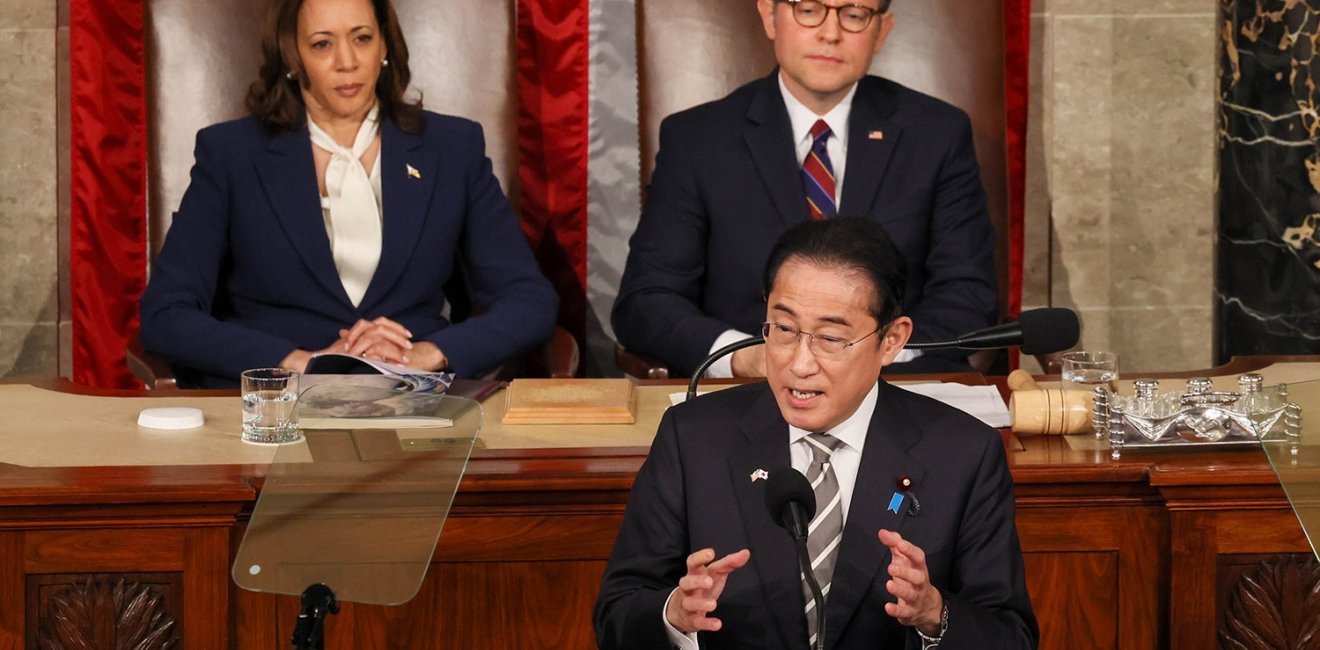
A blog of the Indo-Pacific Program
Prime Minister Kishida of Japan’s US visit, including an address to a joint session of Congress, wasn’t your typical summit that’s heavy on symbolism and ceremony and relatively thin when it comes to substantive achievements. Not this time.
Of course, the increasingly close ties between America and Japan defy geography, history, and culture. It all began in 1853 when Adm. Perry sailed his fleet of “black ships” into Tokyo Bay with the intent of prying open Japan’s insular “hermit kingdom” to international contact and commerce. Many non-Western countries of that era, including China, reacted to such events with a combination of fear and defiance. The Japanese, instead, were intrigued. How was it possible that these foreigners came such a vast distance with such powerful warships? Perry ignited a Japanese fascination with western technologies and a determination to reveal their secrets and replicate them. And they did. Japan became Asia’s first fully modern industrialized country — with a military to match. By the 1930s, the Japanese navy was deploying aircraft carriers capable of transiting the Pacific.
In that same period, Japan’s leaders made a fateful choice. They had mastered the keys to western power, but they chose not to emulate the democratic political systems of North America and Europe. Japan became a de facto military dictatorship animated by a vision of imperial conquest rooted in myths of racial superiority. However, America stood in the way. Following Japan’s invasion of Manchuria, the imperial navy’s entire fleet of six carriers was used to attack Pearl Harbor. For Japan’s military rulers, the ultimate result was an unimaginable catastrophe; Japan was defeated, devastated, and occupied.
Following a long, bloody military campaign culminating in the nuclear destruction of two Japanese cities, not a single American soldier was attacked by any Japanese during the postwar occupation.
Despite heavy US lobbying, Tokyo’s defense budget never exceeded 1 percent of GDP and usually fell short of that
Meanwhile, the United States quickly found itself immersed in a Cold War in Europe and a hot war on the Korean peninsula. Washington looked to Tokyo for help but quickly discovered that postwar Japan was too traumatized, too pacifist, to act as a traditional military ally. Japan was willing to sign a defense treaty and host American military forces, but not participate in any military initiatives beyond the borders of Japan. Despite heavy US lobbying, Tokyo’s defense budget never exceeded 1 percent of GDP and usually fell short of that. American antipathy toward “Red China” was not shared by many Japanese. Instead, many felt guilt and regret over what Japan had done to China during the war and hoped to build a new partnership with China based on a shared Asian identity. In the 1980s, Japan financed a large foreign assistance program in China while Japanese corporations became major investors in that country.
As for the United States and Japan, it would be hard to imagine two allies that are less alike in their cultural/societal makeup. There are many indicators. One is language. Americans tend not to learn foreign languages—but particularly few master Japanese. Whereas Chinese seem to learn English with considerable facility, Japanese typically struggle. This is evident in student enrollments. America has long been a magnet for Chinese students even as relations between the two countries deteriorate. In recent years, the number of Chinese students in the United States has fluctuated around 300,000 at any given time. The comparable number for Japanese is 16,000. The one arena where the “odd couple” of the United States and Japan work together comfortably is in business and finance. Just look at the number of Japanese nameplates on America’s roadways.
That aside, the continued constraints on Japan’s ability and willingness to work with the United States as an allied partner has been a long-standing frustration in the Pentagon—particularly as the military threat from China has grown. But that same threat has also transformed Japanese attitudes. Japanese officials have become increasingly alarmed by two stark realities: China’s military power has grown exponentially while Beijing’s attitude toward Tokyo has become increasingly hostile and threatening. Japan needs a powerful friend and there is only one plausible candidate—America.
One by one, the self-imposed restrictions on Japan’s ability to work with US forces were relaxed.
Japan’s late prime minister, Shinzo Abe, worked tirelessly to convince his countrymen that their future required that Japan become a full, active partner in the US-Japan alliance. One by one, the self-imposed restrictions on Japan’s ability to work with US forces were relaxed. For the first time, Japanese forces could assist their US counterparts outside Japan. For the first time, Japan could provide ships, radars, and other help to friendly Southeast Asian countries. Abe’s successor, Prime Minister Kishida, has grabbed this agenda and run with it.
This is what the recent state visit was all about. Usually, such an event produces three or four concrete “deliverables.” This one produced over seventy that required an eighteen-page fact sheet to list. The net effect is to greatly strengthen the alliance: joint decision-making, joint planning, joint weapons development and maintenance, plus increased joint cooperation with other allies and partners, notably the Philippines, Australia, and Britain. The visit concluded with a trilateral summit with Biden, Kishida, and President Marcos of the Philippines. Kishida pledged that Japan would join the United States in helping protect Philippines ships as they confront Chinese armed maritime forces in the South China Sea. The profound potential consequences of this decision are obvious. Such a step would have been unimaginable a decade ago, but today’s Japan is ready to assume the risks.
Kishida, in his address to Congress, was eloquent and direct. He hailed the United States as the “indispensable nation” and voiced sympathy for Americans “who feel the loneliness and exhaustion of being the country that has upheld the international order almost single-handedly.” But Japan is now a “full global partner” in the alliance — ready to “stand shoulder to shoulder with the United States. You are not alone. We are with you.”
The views expressed are the author's alone, and do not represent the views of the U.S. Government or the Wilson Center. Copyright 2024, The Indo-Pacific Program. All rights reserved.
Follow the Indo-Pacific Program on Twitter @IndoPacific. or join us on Facebook.
Author

Adjunct Professor, Johns Hopkins University; Former Professor of National Security Policy, National War College and Deputy Staff Director, Senate Select Committee on Intelligence

Indo-Pacific Program
The Indo-Pacific Program promotes policy debate and intellectual discussions on US interests in the Asia-Pacific as well as political, economic, security, and social issues relating to the world’s most populous and economically dynamic region. Read more





